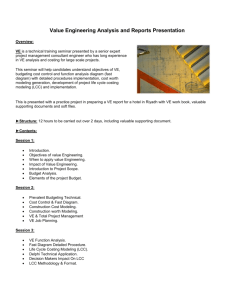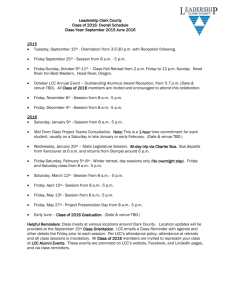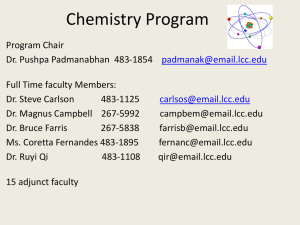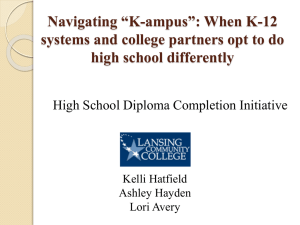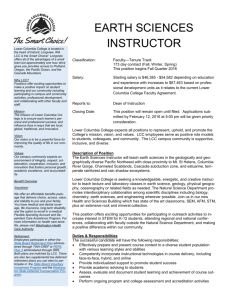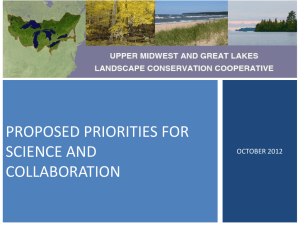ONC LCC WG Goal - (S&I) Framework
advertisement
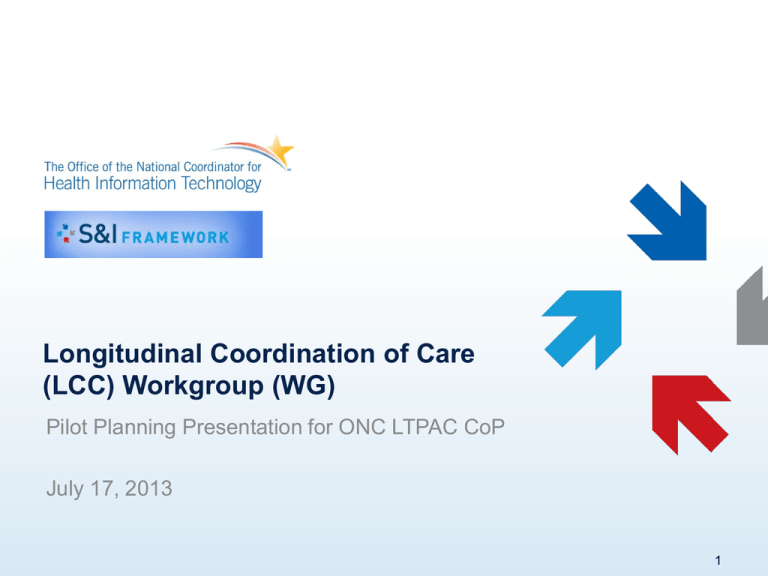
Longitudinal Coordination of Care (LCC) Workgroup (WG) Pilot Planning Presentation for ONC LTPAC CoP July 17, 2013 1 Overview • Introduction: Longitudinal Coordination of Care (LCC) Problem Overview • Role of Standards for Problem Resolution – ONC S&I & LCC WG Overview – Intro to Piloting & Validation of Standards • • • • IMPACT Project NY Project Next Steps Q&A 2 Today • We want you to become pilot sites • We’ll tell you – Why – What needs piloting – How to sign up And the Problems are… Transitions of Care and Longitudinal Coordination of Care (LCC) 4 Patients that Drive Trend • Profile of the high cost patient – Elderly – Frail – Multiple chronic conditions – Functional impairments – Behavioral/cognitive impairments – Dual eligible – With a new superimposed acute illness 5 Number of Chronic Conditions/Pt 6 Per Beneficiary Medicare Spending 7 Proportion of Spending 8 # of Emergency Department Visits/Pt 9 Hospitalizations 10 Readmissions by # of Chronic Conditions 11 Where do patients go after a hospitalization? Everywhere! 12 Post-Acute Care Utilization 13 Consider a Pilot If… • • • • • • • HIE capability exists High proportion of Medicare beneficiaries High proportion of dual eligibles Presence of ACOs and other at risk provider groups High readmission rates Issues with transitions of care Inability to exchange a longitudinal care plan Receiver Needs vs. Sending CCD Data Elements for Longitudinal Coordination of Care IMPACT Data Elements for basic Transition of Care needs CCD Data Elements • Many “missing” data elements can be mapped to CDA templates with applied constraints • 20% have no appropriate templates 15 Piloting Opportunities • New exchange standards for – Home Health Plan of Care – Permanent transfer of care (discharge) – Consultation request and response (PAC to ED and return) – Test/Procedure request and post test response • New software for HIE access Role of Standards in Addressing LCC Limitations 17 What is the S&I Framework? • The Standards and Interoperability (S&I) Framework represents one investment and approach adopted by the Office of Science & Technology (OST) to fulfill its charge of prescribing health IT standards and specifications to support national health outcomes and healthcare priorities • The S&I Framework is an example of “government as a platform”– enabled by integrated functions, processes, and tools – for the open community* of implementers and experts to work together to standardize * As of April 2013, 1100+ people had registered on the S&I Framework wiki, and 450+ people representing 300+ organizations had committed to the S&I Framework 18 ONC’s Interoperability Challenge • Leverage government as a platform for innovation to create conditions of interoperability • Health information exchange is not one-size-fits-all; create a portfolio of solutions that support all uses and users • Build in incremental steps – “don’t let the perfect be the enemy of the good” S&I Longitudinal Coordination of Care (LCC) Workgroup • One of 11 active S&I Initiatives • Initiated in October 2011 as a community-led initiative with multiple public and private sector partners, each committed to overcoming interoperability challenges in long-term, post-acute care (LTPAC) transitions • Goal is to identify standards that support LCC of medically-complex and/or functionally impaired persons that are aligned with and could be included in the EHR Meaningful Use Programs, specifically Meaningful Use Stage 3 • Consists of four sub-workgroups (SWGs): – Longitudinal Care Plan (LCP): focus on Care Plan exchange – LTPAC Care Transition: focus on Transitions of Care – HL7 Tiger Team: Alignment of LCC Care Plan standards with HL7 Care Coordination Services (CSS) and Care Domain Analysis Model (DAM) – Patient Assessment Summary (PAS)*: Balloted C-CDA refinements for patient assessments * The work of the PAS SWG completed in JAN13 20 LCC WG Key Successes to meet MU3 needs • Balloted 3 standards through HL7: – C-CDA Refinements for interoperable exchange of Functional Status, Cognitive Status, Pressure Ulcer & LTPAC Summary; MU2 incorporated requirements for functional and cognitive status – Questionnaire Assessment • Care Plan Glossary: Provides terms/components to unambiguously define a Care Plan – Presented to HITPC in response to MU3 RFC • Two Consensus Voted Use Cases and one robust Dataset (483+ data elements): – Transitions of Care (driven by LTPAC SWG) – Care Plan Exchange (driven by LCP SWG) 21 Lantana C-CDA Revisions Project • Lantana contracted to work with LCC WG to develop Implementation Guidance (IG) based on functional requirements identified in two LCC Use Cases & MA IMPACT Dataset – Sponsored by MA IMPACT Project, NYeC, HealthIX, CCIt-NY, ASPE • IG will be balloted as one Consolidated CDA Revisions Ballot Package with HL7 in August 2013 • Ballot package will address 4 revisions to existing C-CDA (MU Stage 2 standard for electronic transfer of Care Summary): – – – – Update to C-CDA Consult Note Updated Consultation Request Updated Transfer Summary Updated Care Plan document type (will include HHPoC signature requirements and will align with HL7 Patient Care WG's Care Plan Domain Analysis Model- DAM) 22 Next Phase: Piloting & Validation • To ensure the C-CDA Revisions Implementation Guide is both deployment-ready and implementer friendly prior to widespread adoption (and inclusion in MU3 or ONC Certification Program), we need organizations and entities to pilot and validate the IG • LCC Pilot Participants realize several benefits including: – Ability to leverage LCC Initiative Resources – Demonstrate compliance and increase efficiency of development and maintenance – Contribute to the Community – Be recognized as an early adopter • Three organizations/projects committed to piloting LCC C-CDA IG in 2013 are: – MA IMPACT (August 2013) – NY Downstate Care Coordination (Oct 2013) – NYeC (Oct?) 23 Developing Software to Support New CDA Document Types 24 IMPACT Grant February 2011 – HHS/ONC awarded $1.7M HIE Challenge Grant to state of Massachusetts (MTC/MeHI): Improving Massachusetts Post-Acute Care Transfers 25 LAND & SEE • Sites with EHR or electronic assessment tool use these applications to enter data elements – LAND (“Local” Adaptor for Network Distribution) acts as a data courier to gather, transform, and securely transfer data if no support for Direct SMTP/SMIME or IHE XDR • Non-EHR users complete all of the data fields and routing using a web browser to access SEE, their “Surrogate EHR Environment” 26 Sharing LAND & SEE • LAND – Orion Health’s Rhapsody Integration Engine http://www.orionhealth.com/solutions/packages/rhapsody – Currently Modular EHR certified for MU1. MU2 (2014) pending • SEE – Written in JAVA – Baseline functionality software and source code that can connect to Orion’s HISP mailbox via API available for free starting ~October 2013 (Apache Version 2.0 vs. MIT open source license) 27 Piloting LAND & SEE and the new “Transfer of Care” CDA Document 28 Pilot Sites to Test the Datasets • Selection Criteria: – High volume of patient transfers with other pilot sites – Experience with Transitions of Care tools/initiatives • 16 Winning Pilot Sites: – St Vincent Hospital and UMass Memorial Healthcare – Reliant Medical Group (formerly known as Fallon Clinic) and Family Health Center of Worcester (FQHC) – 2 Home Health agencies (VNA Care Network & Overlook VNA) – 1 Long Term Acute Care Hospital (Kindred Parkview) – 1 Inpatient Rehab Facility (Fairlawn) – 8 Skilled Nursing and Extended Care Facilities 29 HIE Guiding Principles A successful HIE needs to: • Provide value (Benefits > Cost) • Fit into real-world workflows • Earn the trust of the stakeholders 30 HIE Guiding Principles Value Pilot Site Learning Collaborative •Understand importance of care transitions Trust •Walk in each other’s shoes –Sender needs to understand what data are needed by receivers and why –Receiver needs to appreciate the difficulty or constraints in collecting data Useable •Satisfy data needs of receivers •Ensure that data collection and transfer leverages existing data and efficiently fits into workflows •Ensure software matches organization’s level of technological progress 31 Other Considerations • Gap between what is currently collected and what is needed • How will you know when it’s ready to send and what the recipient’s address is? • How will copies be printed for patient and ambulance? • Technology needed to make this work (e.g. LAND, SEE, others…)? • Vendor development to make this work? • Do you still need to send CCDs to satisfy “Meaningful Use”? Other Considerations • How will you know when new documents arrive? • Can any of the data elements be re-used? • Additional computers, printers, or chairs required? Are they in the right locations? • Are the monitors big enough for aging eyes? • Do you have the correct browser and version? IMPACT Pilot Go-Live • September 2013 • 10 SEE sites (full Transfer of Care dataset) • 6 LAND sites (initially send CCD but receive any CDA document) • 4/week starting with trading pairs (e.g. Hospital SNF) 34 IMPACT Evaluation Metrics • 30 day hospital readmission rates • ER visit rate • Hospital admission rate from ER • Total Resource Utilization 35 Downstate New York Care Coordination Project July 17, 2013 Overview • Background and Purpose of Project • Project Overview • Budget, Funding • Current Status 37 Context • NYS Medicaid Health Homes have implemented (or are • • • • implementing) care coordination solutions to meet their near term requirements Each Health Home currently uses a separate care management system or EHR In the Downstate NY region, there are many providers who are in multiple Health Homes and multiple RHIOs and their patients will cross borders If various care management tools do not support interoperability, providers may have to use 2 or 3 different systems and this is not sustainable Current state leaves untenable situation of no care plan interoperability 38 Goals and Objectives • Develop consensus around functionality that would enable enhanced care coordination, care plan management and interoperability across Health Homes and RHIOs through the SHIN-NY • Align activity with developments at the national level • Develop Requirements to support the interoperability and joint management of Care Coordination Plans across organizations • Phase I implementation - Demonstrate the ability for two sites with two different care management tools to exchange Care Coordination Plans 39 Short vs. Long Term • To address time constraints of HEAL 17 funds offered by Healthix, • • • • deliverables must be achieved by October 15, 2013 Recognize that Phase I implementation will not meet the immediate operational needs of all Health Homes But believe this is an important activity that could frame state and national interoperability efforts for care coordination Going for long-term pay-off of reducing double data entry Two major capabilities vendors would need to add to their care management systems include: • Capability to save care plans in a standard format and then send it • Ability to consume an external care plan and support changes at the data element level • After this initial phase, we hope to add more vendors to the implementation 40 Collaboration Since the first Downstate Care Coordination Workgroup session in January •Formed Tiger Team with 15-20 representatives from the following stakeholders: • RHIOs in the Greater NY area • Phase 1 and 2 Health Homes in the Greater NY • Health Home partners (e.g., acute care, behavioral health, community-based organizations, home health, long-term care, managed care) • New York eHealth Collaborative (NYeC) • New York State Medicaid Health Home office and the NYC DOHMH •Held five 1-hour weekly discussions with the Tiger Team to build consensus around functionality, explore discussion points, and review updated drafts of the Requirements document •Held ad hoc discussions with subject matter experts to clarify important points •Developed Functional Requirements v.1.0 for the Workgroup’s review • In addition to Requirements, the document includes: Revision history, Use Case, Assumptions, Founding Principles, Consent Considerations, Technical Considerations, Features for Future Consideration 41 Requirements The DCC Workgroup agreed upon the following seven functions: • Enrollment of Health Home patients • Linking of patients and providers: care teams • Exchange of interoperable care plans • Clinical Event Notifications • Secure Messaging • Access to medical records for clinicians • Access to care plans for non-clinicians 42 Care Coordination Plan (CCP) Collaboration What is a CCP? • Care Coordination Plan (CCP) refers to a shared document that is used to track problems, goals, interventions and outcomes related to both clinical and social issues • CCPs are a focus of collaboration for diverse care teams across organizations 43 Care Coordination Plan (CCP) Collaboration Founding Principles • Functionality must demonstrate the exchange of CCPs between at least two different organizations using different tools • Different care management systems must have the ability to interoperate, specifically, to allow a CCP to: 1. 2. 3. 4. Be authored in one tool; Consumed by another tool; Returned to the original system; and Saved in the RHIO where it can be viewed by any authorized user. • The RHIO will serve as a universal place where all qualified care team members can view a current copy of the CCP • Vendors will be expected to comply with standards for a CCP • 44 Standards are being developed by the Longitudinal Care Coordination workgroup (http://wiki.siframework.org/Longitudinal+Coordination+of+Care) under the ONC’s Standards & Interoperability Framework (available for vendors this spring 2013) Care Coordination Plan (CCP) Collaboration Use Case 1. Author will create and edit the CCP in a care management tool that uses a national agreed upon structure for interoperable CCPs v1 Author Editor v1 edits v1 RHIO Iterative process based on interoperability standards v1 View only 3. Reader can view the most recent CCP in the RHIO, and provide comments to the Author through secure messaging 45 2. Editor will view the CCP in their local care management tool, and suggest edits to the Author for review and approval. The Author retains editorial control of the CCP Reader Budget and Funding • Healthix received funding from the NYS DOH Health Care Efficiency and Affordability Law (HEAL) Program • The aim of the grant is “Expanding Care Coordination Through the Use of Interoperable Health Information Technology” • Healthix has allocated approximately one million dollars to spearhead this initiative • $760K reimbursed to the provider and their vendors • $100K to cover Healthix technical development and project management • $100K to support standards effort • Approximately $200K in-kind contributions by Continuum Health Partners 46 Healthix HEAL 17 – Project Highlights • Identified two sites with two different vendors to participate in Phase 1 implementation, both part of Continuum Health Partners • Addiction Institute of New York • Methodone Treatment Program (Netsmart) • Outpatient Treatment Program (Caradigm) • Held kick off meeting with stakeholders in early June • Agreed on Requirements and Phase 1/2 development • June –Design phase in progress, will finalize Design document by end of June • July - August: Development, finalize draft data model for the standard Care Coordination Plan with the LCC Standards Workgroup • September: Testing, Acceptance • October: Phase 1 Implementation, Evaluation 47 Phase I Implementation - CCP Collaboration Author Editor Netsmart v1 Caradigm AINY Methodone Treatment Program v1 edits AINY Outpatient Treatment Program v1 v1 Addiction Institute of New York (AINY) is a Division of the Department of Psychiatry at St. Luke’s-Roosevelt Hospital Center and is affiliated with the Columbia University College of Physicians and Surgeons. Both sites participating in the Phase 1 implementation (MTP and OTP) are clinical treatment programs of AINY. 48 Iterative process based on interoperability standards RHIO View only Reader Healthix Clinical Viewer Downstream Providers THANK YOU Tom Moore Vice President, Innovation tmoore@healthix.org 49 NEXT STEPS 50 Next Steps Participate in LCC Pilots Workgroup (WG)! LCC Initiative establishing the LCC Pilots Workgroup in August WG will serve to organize and guide deployment of Pilot projects that will test the suitability of the LCC Consolidated CDA IG in real-world settings WG will provide additional guidance on planning, executing and monitoring of Pilot Projects LCC WG is inviting interested parties to complete the LCC Pilot Interest Survey form: http://wiki.siframework.org/LCC+Pilot+Interest+Survey 51 LCC Initiative: Resources & Questions • • • • • LCC Leads – Dr. Larry Garber (Lawrence.Garber@reliantmedicalgroup.org) – Dr. Terry O’Malley (tomalley@partners.org) – Dr. Bill Russell (drbruss@gmail.com) – Sue Mitchell (suemitchell@hotmail.com) LCC/HL7 Coordination Lead – Dr. Russ Leftwich (Russell.Leftwich@tn.gov) Federal Partner Lead – Jennie Harvell (jennie.harvell@hhs.gov) Initiative Coordinator – Evelyn Gallego (evelyn.gallego@siframework.org) Project Management – Becky Angeles (becky.angeles@esacinc.com) – Lynette Elliott (lynette.elliott@esacinc.com) LCC Wiki Site: http://wiki.siframework.org/Longitudinal+Coordination+of+Care 52
